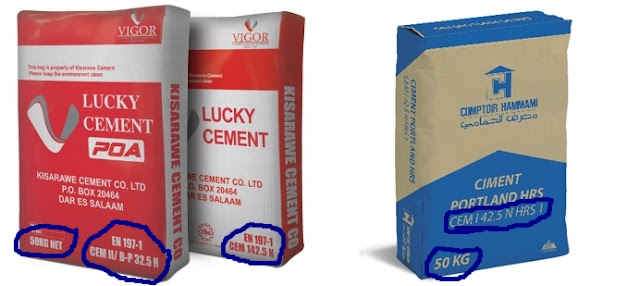WHAT DO LABELS ON CEMENT BAGS MEAN?
DIFFERENT LABELS OF
WORDS ON CEMENT BAGS HAVE DIFFERENT MEANING THAT COULD HELP YOU TO KNOW THE
BETTER CEMENT FOR YOUR WORK.
1. LABELS
THAT SHOW THE QUANTITY OF CEMENT
The
quantity of cement bags is measured in kilograms (Kgs), most of the cement bags
quantity is 50 kilograms which is labels as 50 KG or 50KG NET as shown in the
cement in above pictures.
2. LABELS
THAT SHOW THE MATERIALS USED ON PRODUCTION
The
materials used for the production of cement are shown by using the
abbreviation, so when it comes to the composition and ingredients in cement,
there are five main types. There are denoted by a CEM value printed on the bag.
The CEM value outlines the basic ratios and blends of ingredients used to make
the cement.
i.
CEM I - The cement is Portland cement
ii.
CEM II - Portland slag cement, Portland
Silica fume cement, Portland Pozzolana cement, Portland Fly ash cement,
Portland burnt shale cement, Portland Limestone cement and Portland composite
cement.
iii.
CEM III
- Blast furnace cement
iv.
CEM IV
- Pozzolanic cement
v.
CEM V
– Composite cement
3. THE
STRENGTH OF THE CEMENT
This specify the grades by
considering the strength of cement and also this determines the cost the cement
bag.
MC 22.5X
This is the masonry cement denoted
by MC the X in the strength class means that the cement does not contain an air
entraining or trapping agent. This class of cement is perfect for making
mortars, smooth plaster, screeds and soil stabilized blocks.
32.5N
This
is the strength class of standard cement for a general application the ‘N’ in
the cement class denotes normal strength. This cement is used when initial high
strength is not required during the curing phase. This is the most widely used
type of cement, it is economical and has a vast range of uses.
32.5R
Like the standard class of cement,
32.5R is the great for general applications. The ‘R’ denotes rapid strength.
This cement cures quickly and is referred to as quick set or fast setting
cement. It cures quickly and develops strength early on in the curing phase.
42.5N
The stronger class of cement, able
to withstand higher pressures and loads. This class of cement should be used
when a higher initial strength is needed during the curing phase; mainly to
support the weight of a heavy structure.
42.5R
Like the stronger class of cement,
42.5R is able to withstand higher pressures and loads.. The ‘R’ denotes rapid
strength. This cement cures quickly and is referred to as quick set or fast
setting cement. It cures quickly and develops strength early on in the curing
phase
CEMENT CONSTITUENTS AND ITS LABELS ON BAG
EXAMPLE 1:CEMENT CONSTITUENTS AND ITS LABELS ON BAG
- Portland cement clinker (K)
- Granulated blastfurnace slag (S)
- Natural Pozzolana (P)
- Natural calcined Pozzolana (Q)
- Siliceous fly ash (V)
- Calcareous fly ash (W)
- Burnt shale (T)
- Limestone (L, LL)
- Silica fume (D)
Standard designation
Below examples shows how labels on cement bags are designed with its meaning on cement bagsPortland cement conforming to EN 197-1 of strength class 42,5 with a high early strength is
identified by:
Portland cement EN 197-1 - CEM I 42,5 R
EXAMPLE 2:
Portland-limestone cement containing between 6 % and 20 % by mass of limestone with a Total Organic Content (TOC) not exceeding 0,50 % by mass (L) of strength class 32,5 with an ordinary early strength is
identified by:
Portland-limestone cement EN 197-1- CEM II/A-L 32,5 N
EXAMPLE 3:
Portland-composite cement containing in total a quantity of granulated blastfurnace slag (S),
siliceous fly ash (V) and limestone (L) of between 6 % and 20 % by mass and of strength class
32,5 with a high early strength is identified by:
Portland-composite cement EN 197-1- CEM II/A-M (S-V-L) 32,5 R
EXAMPLE 4:
Composite cement containing between 18 % and 30 % by mass of granulated blastfurnace slag
(S) and between 18 % and 30 % by mass of siliceous fly ash (V) of strength class 32,5 with an
ordinary early strength is identified by:
Composite cement EN 197-1 - CEM V/A (S-V) 32,5 N
From now you can understand better what is inside the cement bag by only reading the labels on the cement bag.
RELATED POSTS




Comments
Post a Comment